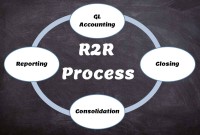- Home
- Business Processes
- Industry Knowledge
- Aerospace Industry
- Automotive Industry
- Banking Domain
- BFSI Industry
- Consumer/ FMCG Industry
- Chemicals Industry
- Engineering & Construction
- Energy Industry
- Education Domain
- Finance Domain
- Hospitality Domain
- Healthcare Industry
- Insurance Domain
- Retail Industry
- Travel and Tourism Domain
- Telecom Industry
- Leadership Skills
- eLearning
- Home
- Functional
- General Ledger (Record to Report)
- Company Form
Company Form
A Company (also called corporation) may be understood as an association of persons in which money is contributed by them, to carry on some business or undertaking. Persons who contribute the money are called the shareholders or the members of the company. A corporation is an artificial being, invisible, intangible and existing only in contemplation of law. Being the mere creature of law, it possesses only those properties which the charter of its creation confers upon it.
Definition of Company/Corporation
A Company (also called corporation) may be understood as an association of persons in which money is contributed by them, to carry on some business or undertaking. Persons who contribute the money are called the shareholders or the members of the company. A corporation is an artificial being, invisible, intangible and existing only in contemplation of law. Being the mere creature of law, it possesses only those properties which the charter of its creation confers upon it, either expressly or an incidental to its very existence. It is an association of many persons, who contribute money or money's worth to a common stock and employ it for a common purpose. The common stock so contributed is denoted in money and is the capital of the company. The persons who contribute it or to whom it belongs are members. The proportion of capital to which each member is entitled is his share.
Main Features
- Once incorporated, a company assumes the identity of an artificial person
- An incorporated company is a corporate body and by action of law it is treated as a legal person
- The company may sue or be sued by its members/shareholders
- The company can enter into contracts in its own name and likewise may sue and be sued in its own name
- The company is a separate legal entity distinct from its management and shareholders
- Company affairs are managed by a Board of Directors
- A company has perpetual existence and is not effected by the joining, leaving, death, insolvency or insanity of any of its shareholders
- The shares of a Joint Stock company (except private company) are freely transferable
- A private company through its articles may place certain restrictions on the transferability of its shares
- In case of a company limited by share, the liability of the members of the company is limited to the nominal value of
- shares held by them
- Capital for the company is contributed by a number of persons called shareholders
- Large number of shareholder give ability to company to raise large amount of capital
- Shareholder is not the agent of the company or its shareholders and hence he cannot bind company with his acts
- The scope of the business of a company is limited and restricted to what is mentioned in the 'object clause' of its Memorandum of Association. The company cannot take up any new business without changing the object clause.
To summarize shareholders are the real owners of the company, Their liability is limited. They can also transfer their shares to others. Since the shareholders are very large in number, the company cannot be managed by all. They elect a board of directors to manage the company. The destiny of the company is guided and directed by the directors. These directors employ some people to carry on the day-to-day business of the company.
Different types of companies
Statutory Company: A company established by a special Act of the Parliament or State Legislature is called 'Statutory Company'. Such companies are established in special cases when it is necessary to regulate the working of the company for some specific purposes. Examples of such corporations are Central Banks etc.
Chartered Company: A company which is incorporated under a special Royal Charter granted by the Monarch is called a 'Chartered Company'. It is regulated by the provisions of that charter. Examples are: British East India Company, Bank of England, Hudson's Bay Company, etc.
Unlimited Company: A company in which the liability of the members is unlimited, is called 'Unlimited Company'. At the time of winding up of the company shareholders have to pay, if necessary, from their personal assets to clear the company's debts. Such companies are very rare.
Companies Limited by Guarantee: In the case of some companies, members give guarantee for the debts of the company up to a certain limit in addition to the amount of shares held by them. The additional amount guaranteed by the members is, generally, laid down in the Memorandum of Association. Such companies are not formed for the purpose of profit. They are formed to promote art, culture, religion. trade, sports, etc. Clubs, Charitable organizations, trade association, etc. come under this category.
Companies Limited by Shares: In this case the liability of the members is limited to the amount of the shares held by them. A shareholder can be called upon to pay only the unpaid amount of shares held by him and nothing more. Most of the companies come under this category.
Private Limited Company: A private limited company means a company which by its article restricts the right to transfer its shares; limits the number of its members; and prohibits any invitation to the public to subscribe for any shares or debentures of the company.
Public Limited Company: A public limited company is one which is not a private limited company. The right of the shareholder to transfer his shares is not restricted and it can invite public to subscribe for its shares and debentures.
Government Company: A company in which not less than 5 1 per cent of the paid up share capital is held by the Central Government, or by any State Government or jointly by Central and/or State Governments.
National Company: When the operations of a company are confined within the boundaries of the country in which it is registered, such a company is called a national company.
Multinational Company: When the operations of a company are extended beyond the boundaries of the country in which it is registered, such a company is called a multinational company. It is also called 'transnational company'.
Foreign Company: Foreign Company refers to a company that operates in the foreign country outside the country of its registration.
Holding and Subsidiary Company: A subsidiary is a company that is completely or partly owned by another company known as holding company.
Related Links
You May Also Like
-
Record to report (R2R) is a finance and accounting management process that involves collecting, processing, analyzing, validating, organizing, and finally reporting accurate financial data. R2R process provides strategic, financial, and operational feedback on the performance of the organization to inform management and external stakeholders. R2R process also covers the steps involved in preparing and reporting on the overall accounts.
-
What is a Business Eco System?
The goal of a business is to generate capital appreciation and profits for its owners or stakeholders by engaging in provision of goods and services to customers within the eco system/framework governed by respective laws(local/international). The eco system involves various entities that the business works with for delivery of a product or service.
-
Divisional Organizational Structures
The divisional structure or product structure consists of self-contained divisions. A division is a collection of functions which produce a product. It also utilizes a plan to compete and operate as a separate business or profit center. Divisional structure is based on external or internal parameters like product /customer segment/ geographical location etc.
-
As the business grows, the company may want to transition to a branch structure as branches are allowed to conduct a much broader range of activity than representative offices. Branches can buy and sell goods, sign contracts, build things, render services, and generally everything that a regular business can do. A company expands its business by opening up its branch offices in various parts of the country as well as in other countries.
-
Horizontal or Flat Organizational Structures
Flat organizational structure is an organizational model with relatively few or no levels of middle management between the executives and the frontline employees. Its goal is to have as little hierarchy as possible between management and staff level employees. In a flat organizational structure, employees have increased involvement in the decision-making process.
-
This article explains the process of entering and importing general ledger journals in automated accounting systems. Learn about the basic validations that must happen before the accounting data can be imported from any internal or external sub-system to the general ledger. Finally, understand what we mean by importing in detail or in summary.
-
Trial Balance in General Ledger
One of the greatest benefits of using a double-entry accounting system is the capability to generate a trial balance. What do we mean by trial balance? As the name suggests a trial balance is a report that must have its debits equals to credits. Understand the importance of trial balance and why it is balanced. Learn how it is prepared and in which format.
-
There are five types of core accounts to capture any accounting transaction. Apart from these fundamental accounts, some other special-purpose accounts are used to ensure the integrity of financial transactions. Some examples of such accounts are clearing accounts, suspense accounts, contra accounts, and intercompany accounts. Understand the importance and usage of these accounts.
-
An account inquiry is a review of any type of financial account, whether it be a depository account or a credit account. In this tutorial, you learn what we mean by drill through functionality in the context of the general ledger system. We will explain the concept of drill-down and how it enables users to perform account and transaction inquiry at a granular level and the benefits of using this functionality.
-
The general ledger is the central repository of all accounting information in an automated accounting world. Summarized data from various sub-ledgers are posted to GL that eventually helps in the creation of financial reports. Read more to understand the role and benefits of an effective general ledger system in automated accounting systems and ERPs.
Explore Our Free Training Articles or
Sign Up to Start With Our eLearning Courses

About Us
Learning
© 2023 TechnoFunc, All Rights Reserved










